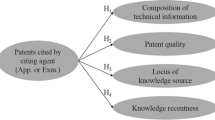Abstract
This paper briefly reviews the knowledge-generation process and explores to what degree technical and scientific knowledge from prior art anticipates novelty or the inventive step of an invention. Inventions are novel if they have not been described (in the public) before, and they are inventive if the technical solution was non-obvious to a skilled person in the field. We employ a novel approach of patent citation analysis to investigate this phenomenon. Since in this context common approaches of such citation analysis are biased (usually, citations are neither exhaustive nor relevant in their entirety), we focus on examination reports of European patent applications and the references given therein. Our findings reveal that particularly technical knowledge comprised in patents serves as a source of novelty, while scientific knowledge frequently stems from multiple scientific papers and accounts for the inventive step. In addition, it is found that in many cases scientific knowledge is of commercial relevance and therefore constitutes more than general background information that aids the technical knowledge generation process.
Similar content being viewed by others
References
Callaert, J., VAN LOOY, B., Verbeek, A., Debackere, K., Thijs, B. (2006), Traces of Prior Art: An analysis of non-patent references found in patent documents, Scientometrics, 69: 3–20.
DTI/OST DTI/OST Technology group & IPC (2006), Subclass Mapping http://www.ipaustralia.gov.au/pdfs/statistics/Technology%20Groups.doc (June 27, 2006).
EPO (2005), Guidelines for Examination, Part B, Chapter IV, Search Procedure and Strategy http://www.european-patent-office.org/legal/gui_lines/e/b_iv_3_1.htm (13 Oct 2005).
Ernst, H. (1996), Patentinformationen für die strategische Planung von Forschung und Entwicklung, DUV, Wiesbaden.
Fleming, L., Sorenson, O. (2004), Science as a map in technological search, Strategic Management Journal, 25: 909–928.
Fleming, L. (2001), Recombinant Uncertainty in Technological Search, Management Science, 47: 117–132.
Gordon, M. D., Lindsay, R. K. (1996), Toward discovery support systems: A replication, re-examination, and extension of Swanson’s work on literature-based discovery of a connection between Raynaud’s and fish oil, Journal of the American Society for Information Science, 47: 116–128.
Harter, S. P., Nisonger, T. E., Weng, A. (1993), Semantic relationships between cited and citing articles in library and information science journals, Journal of the American Society for Information Science, 44: 543–552.
Hicks, D., Breitzman, T., Olivastro, D., Hamilton, K. (2001), The changing composition of innovative activity in the US — a portrait based on patent analysis, Research Policy, 30: 681–703.
Jaffe, A. B., Trajtenberg, M., Fogarty, M. S. (2000), The meaning of patent citations: report on the NBER/case-western reserve survey of patentees, NBER, Cambridge, Mass.
Kajikawa, Y., Abe, K., Noda, S. (2006), Filling the gap between researchers studying different materials and different methods: a proposal for structured keywords, Journal of Information Science, 32: 511–524.
Kessler, M. M. (1963), Bibliographic coupling between scientific papers, American Documentation, 14: 10–25.
Marshakova, I. V. (1973), System of document connections based on references, Scientific and Technical Information Serial of VINITI, 6: 3–8.
Meyer, M. (2000), Patent citations in a novel field of technology - What can they tell about interactions between emerging communities of science and technology? Scientometrics, 48: 151–178.
Nelson, R. R., Winter, S. G. (1982), An evolutionary theory of economic change, Belknap Press of Harvard Univ. Press, Cambridge, Mass.
Nonaka, I., Toyama, R., Nagata, A. (2000), A firm as a knowledge-creating entity: a new perspective on the theory of the firm, Industrial and Corporate Change, 9: 1–20.
Polanyi, M. (1966), The Tacit Dimension, Doubleday, Garden City N. Y.
Quintana-García, C., Benavides-Velasco, C. A. (2008), Innovative competence, exploration and exploitation: The influence of technological diversification, Research Policy, 37: 492–507.
Sampat, B. N. (2004), Examining Patent Examination: An Analysis of Examiner and Applicant Generated Prior Art, http://faculty.haas.berkeley.edu/wakeman/ba297tspring05/Sampat.pdf (16 Jan 2006).
Schmoch, U. & al., (1988), Technikprognosen mit Patentindikatoren: zur Einschätzung zukünftiger industrieller Entwicklungen bei Industrierobotern, Lasern, Solargeneratoren und immobilisierten Enzymen, TÜV Rheinland, Köln.
Schmoch, U. (1993), Tracing the knowledge transfer from science to technology as reflected in patent indicators, Scientometrics, 26: 193–212.
Schumpeter, J. A. (1952), Theorie der wirtschaftlichen Entwicklung: eine Untersuchung über Unternehmergewinn, Kapital, Kredit, Zins und den Konjunkturzyklus, Duncker Humblot, Berlin.
Small, H. (1973), Co-citation in the scientific literature: A new measure of the relationship between two documents, Journal of the american Society for Information Science, 24: 265–269.
Sternitzke, C., Bergmann, I. (2009), Similarity measures for document mapping: a comparative study on the level of an individual scientist, Scientometrics, 78: 113–130.
Sternitzke, C. (2009), The international preliminary examination of patent applications according to the Patent Cooperation Treaty — a proxy for patent value? Scientometrics, 78: 189–202.
Swanson, D. R., Smalheiser, N. R. (1997), An interactive system for finding complementary literatures: a stimulus to scientific discovery, Artificial Intelligence, 91: 183–203.
Swanson, D. R. (1986), Fish oil, Raynaud’s syndrome, and undiscovered public knowledge, Perspectives in Biology and Medicine, 30: 7–18.
Swanson, D. R. (1987), Two medical literatures that are logically but not bibliographically connected, Journal of the American Society for Information Science, 38: 228–233.
Thompson, P. (2004), Patent Citations and the Geography of Knowledge Spillovers: What Do Patent Examiners Know? Florida International University, http://www.fiu.edu/~thompsop/current/adobe/examiner.pdf (17-May-2005).
Weeber, M., Klein, H., De Jong-Van Den berg, L. T. W., Vos, R. (2001), Using concepts in literaturebased discovery: Simulating Swanson’s Raynaud-fish oil and migraine-magnesium discoveries, Journal of the American Society for Information Science and Technology, 52: 548–557.
Author information
Authors and Affiliations
Corresponding author
Rights and permissions
About this article
Cite this article
Sternitzke, C. Patents and publications as sources of novel and inventive knowledge. Scientometrics 79, 551–561 (2009). https://doi.org/10.1007/s11192-007-2041-0
Received:
Published:
Issue Date:
DOI: https://doi.org/10.1007/s11192-007-2041-0




